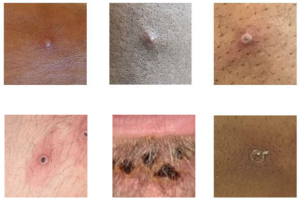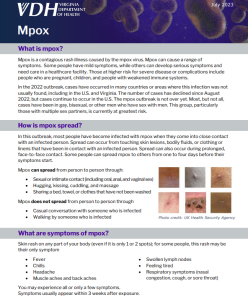About Mpox
Mpox is a contagious rash illness caused by the mpox virus. It's primarily spread by close personal contact with someone who has mpox.
While anyone can get mpox, most people infected with mpox in the United States have been gay, bisexual, or other men who have sex with men.
The best way to prevent mpox is by getting vaccinated with both doses.
Symptoms of Mpox
The rash can look like pimples or blisters. It can appear on the hands, feet, chest, face, genitals, in and around the mouth, or perianal area. The perianal area is near the penis, testicles, labia, vagina, and anus. It can sometimes be confused with more common sexually transmitted infections (STI), like herpes or syphilis.
The rash might develop on only one part of the body or can appear on many parts of the body. The rash might be painful or itchy.
For some people, a rash may be their only symptom.

Photo credit: UK Health Security Agency
Other mpox symptoms can happen before or after you get a rash. These include:
- Fever or chills
- Headache
- Muscle aches and backache
- Tiredness
- Respiratory symptoms (e.g., sore throat, nasal congestion, or cough)
- Swollen lymph nodes
Mpox symptoms usually start within 3 weeks of exposure to the virus and are usually mild but can be severe. People with mpox often get a rash. For some people, the illness starts with flu-like symptoms that begin a few days before a rash appears.
The illness lasts 2-4 weeks. If you have a rash, keep it covered and stay away from others until it has healed and a new layer has formed. People with mpox are contagious until all their scabs fall off and a fresh layer of intact skin forms. This can take 2–4 weeks.
People with certain conditions might be more likely to develop severe illness. People who are more likely to develop severe illness include:
- people with weakened immune systems
- children under 1 year of age
- people with a history of eczema and
- people who are pregnant or breastfeeding.
If you have severe symptoms of mpox or you are at high risk for developing severe mpox symptoms, contact your healthcare provider about possible medical treatment.
How Mpox is Spread
The virus spreads mostly through close, intimate contact with someone who has mpox.
Close contact means touching any of the following of an infected person:
- touching rashes
- touching bodily fluids
- touching the clothing or linens that have touched a sick person's rash or body fluids
Mpox CAN spread from person to person through:
- Sexual or intimate contact (including oral, anal, and vaginal sex)
- Hugging, kissing, cuddling, and massage
- Sharing a bed, towel, clothes, or other personal items that have not been washed
- Prolonged, face-to-face contact.
Mpox does NOT spread from person to person through:
- Walking by someone with mpox
- Casual conversation with someone with mpox
People who engage in close personal contact with an infected person are at highest risk. The highest risk activities are intimate or sexual contact. Reducing or avoiding these activities lowers your risk of catching or spreading mpox.
- Most daily activities are relatively low risk. Good health habits like proper handwashing can help reduce the risk and spread of mpox.
- Vaccination is an important tool to prevent the spread of mpox. Avoid or reduce behaviors that increase your risk of exposure if you still need a second dose of vaccine.
- As you prepare to attend events and celebrations, visit the CDC website to see how you can stay healthy.
Infected animals can spread mpox to people. So, it’s possible that people who are infected can spread mpox to animals and they might spread it through close contact. This includes petting, cuddling, hugging, kissing, licking, sharing sleeping areas, and sharing food.
Prevent spreading mpox by avoiding contact with pets, domestic animals, and wild animals.
For more information:
Prevent the Spread
- If you are eligible for mpox vaccine, get vaccinated .The JYNNEOS vaccine is safe and effective. Be sure to get both doses for the best protection
- Even if you are vaccinated, avoid contact with people who have a rash that looks like mpox. CDC has information about prevention for people who are sexually active
- Do not share any of the following with someone who has mpox:
- Tableware or other eating utensils
- Clothing
- Bedding
- Towels or
- Personal grooming devices
- Wash your hands often with soap and water or use an alcohol-based hand sanitizer
- Wear a mask if you think you'll have lengthy or close face-to-face contact with people who might have mpox
- Stay home (isolate) away from people and animals until your mpox rash has healed and a new layer of skin has formed
- If you need to be around others, keep rashes covered and wear a mask
- Do not share any of the following with others:
- Tableware or other eating utensils
- Clothing
- Bedding
- Towels or
- Personal grooming devices
- Notify your close contacts as soon as possible. This way, they can watch for symptoms and get tested if they have symptoms. They might also be eligible for a vaccine
- Visit the CDC website for more tips on how to prevent spreading mpox to others
If You're Sick
If you have symptoms, avoid contact with people and pets and keep your rash covered.
Visit your healthcare provider to see if you should get tested for mpox. Call ahead before going to a healthcare facility and let them know that you are concerned about mpox. They might ask screening questions before they schedule you for testing.
- If you have a rash that looks like mpox
- If you had close contact with someone who has mpox and think you have symptoms of mpox
If you think you were exposed to mpox or may be infected with mpox, you should contact your healthcare provider. A healthcare provider can examine your symptoms and help decide if you need a vaccine or test. If you are sick with mpox, they can also help you manage your illness and prescribe medication if you need it.
If you do not have a healthcare provider, you can contact a public health clinic. You can use these resources to find a public health clinic:
The cost of mpox testing depends on where you get it.
If a private healthcare provider refers you to a commercial lab or hospital, there may be a fee involved.
Tests conducted by public health departments are usually free.
Last updated: July 12, 2024
Opens pdf to download
Opens document to download
Opens in a new window
External link will open in a new window. Click link to exit Virginia Department of Health Website.




